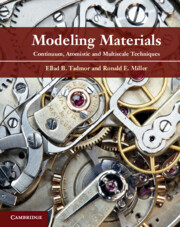Book contents
- Frontmatter
- Contents
- Preface
- Acknowledgments
- Notation
- 1 Introduction
- Part I Continuum mechanics and thermodynamics
- Part II Atomistics
- 3 Lattices and crystal structures
- 4 Quantum mechanics of materials
- 5 Empirical atomistic models of materials
- 6 Molecular statics
- Part III Atomistic foundations of continuum concepts
- Part IV Multiscale methods
- Appendix A Mathematical representation of interatomic potentials
- References
- Index
4 - Quantum mechanics of materials
from Part II - Atomistics
Published online by Cambridge University Press: 05 June 2012
- Frontmatter
- Contents
- Preface
- Acknowledgments
- Notation
- 1 Introduction
- Part I Continuum mechanics and thermodynamics
- Part II Atomistics
- 3 Lattices and crystal structures
- 4 Quantum mechanics of materials
- 5 Empirical atomistic models of materials
- 6 Molecular statics
- Part III Atomistic foundations of continuum concepts
- Part IV Multiscale methods
- Appendix A Mathematical representation of interatomic potentials
- References
- Index
Summary
Introduction
In the preface to his book on the subject, Peierls says of the quantum theory of solids [Pei64]
[It] has sometimes the reputation of being rather less respectable than other branches of modern theoretical physics. The reason for this view is that the dynamics of many-body systems, with which it is concerned, cannot be handled without the use of simplifications, or without approximations which often omit essential features of the problem.
This book, in essence, is all about ways to further approximate the quantum theory of solids; it is about ways to build approximate models that describe the collective behavior of quantum mechanical atoms in materials. Whether it is the development of density functional theory (DFT), empirical classical interatomic potentials, continuum constitutive laws or multiscale methods, one can only conclude that, by Peierls' measure, modeling materials is a science that is a great deal less respectable than even the quantum theory of solids itself. However, Peierls goes on to say that
Nevertheless, the [quantum] theory [of solids] contains a good deal of work of intrinsic interest in which one can either develop a solution convincingly from first principles, or at least give a clear picture of the features which have been omitted and therefore discuss qualitatively the changes which they are likely to cause.
It is our view that these redeeming qualities are equally applicable to the modern science of modeling materials.
- Type
- Chapter
- Information
- Modeling MaterialsContinuum, Atomistic and Multiscale Techniques, pp. 153 - 236Publisher: Cambridge University PressPrint publication year: 2011



